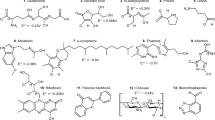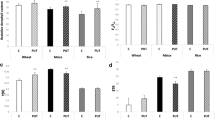Abstract
Changes in the activity of several enzymes in corn seedlings (Zea mays L.) after 1-triacontanol (TRIA) application have been analyzed. The specific activity of isocitrate dehydrogenase and 6-phosphogluconate dehydrogenase in corn seedlings treated with TRIA increased rapidly. Three days after treatment, the TRIA-treated seedlings showed 89% and 39% more ICDH and 6PGDH activity per mg protein, respectively, than the untreated plants. Malate dehydrogenase activity increased in treated plants at a rate approximately equivalent to the increase in soluble protein. Acid phosphatase, peroxidase, and alkaline phosphatase activity remained relatively constant on a per plant basis and decreased slightly on a per mg protein basis. No qualitative changes were observed in the isozyme patterns of the enzymes analyzed by starch gel electrophoresis, although quantitative changes consistent with the increases using spectrophotometric assays were observed.
Similar content being viewed by others
References
Brewbaker J, Hasegawa Y (1975) Polymorphisms of the major peroxidases of maize. In: Markert C (ed) In the isozymes. Academic Press, New York
Curry R, Ting I (1976) Purification, properties and kinetic observations on the isoenzymes of NADP isocitrate dehydrogenase of maize. Arch Biochem Biophys 176:501–509
Eriksen AB, Sellden G, Skogen D, Nilsen S (1981) Comparative analysis of the effect of triacontanol on photosynthesis, photorespiration and growth of tomato (C3-plant) and maize (C4-plant). Planta 152:44–49
Fan D, Maclachlan G (1967) Massive synthesis of RNA and cellulase in the pea epicotyl in response to IAA, with and without concurrent cell division. Plant Physiol 42:1114–1127
Ferrari A (1979) Nitrogen determination by a continuous digestion and analysis system. NY Acad Sci 87:792–800
Gibson D, Liu E (1978) Substrate specificities of peroxidase isozymes in the developing pea seedlings. Ann Bot 42:1075–1083
Gibson TW (1982) Hydrozirconation/oxidation of internal olefins: A simple synthesis of triacontanol. Tetrahedron Letters 23:157
Houtz RL (1980) Development and characterization of an in vitro system responsive to triacontanol. MS Thesis, Michigan State University, East Lansing, Michigan
Jones J, Wert VF, Ries SK (1979) Specificity of 1-triacontanol as a plant growth stimulator and inhibition of its effects by other long-chain compounds. Planta 144:277–282
Knowles NR, Ries SK (1981) Rapid growth and apparent total nitrogen increases in rice and corn plants following application of triacontanol. Plant Physiol 68:1279–1284
Laughlin RG, Munyon RL, Ries SK, Wert VF (1983) Growth enhancement of plants by femtomole doses of collodially dispersed triacontanol. Science 219:1219–1221
Lowry L, Rosebrough N, Fan A, Randall R (1951) Protein measurements with the folin phenol reagent. J Biol Chem 193:265–275
Ochoa S (1955) Malic dehydrogenase from pig heart. Methods in Enzymology 1:735–739
Reid T, Wilson I (1971)E. coli alkaline phosphatases. In: Boyer P (ed) The enzymes, vol 4, Academic Press, New York
Ries SK, Richman T, Wert VF (1978) Growth and yield of crops treated with triacontanol. J Amer Soc Hort Sci 103:361–364
Ries SK, Wert VF (1977) Growth response of rice seedlings to triacontanol in light and dark. Planta 135:77–82
Ries SK, Wert VF (1982) Rapid effects of triacontanol in vivo and in vitro. J Plant Growth Regul 1:117–127
Ries SK, Wert VF, Sweeley CC, Leavitt RA (1977) Triacontanol: A new naturally occurring plant growth regulator. Science 195:1339–1341
Sako N, Stahmann M (1972) Multiple molecular forms of enzymes in barley leaves infected withErysiphe graminis f. sp. hordei. Physiol Plant Pathol 2:217–226
Scandalious J (1969) Genetic control of multiple molecular forms of enzymes in plants: A review. Biochem Genetics 3:37–79
Uritani I (1978) Biochemistry of host responses to infections. In: Reinhold L, Harborne J, Swain T (eds) Progress in phytochemistry, vol 5. Pergamon Press, Oxford, England
Zheng A, Chen J, Ye X, Qian C, Deng D, Qiao Y (1981) Stimulation of highly pure 1-triacontanol on the physiological function of cotton seedlings. Scientia Agriculture Sinica 2:27–30
Author information
Authors and Affiliations
Additional information
Michigan Agricultural Experiment Station Journal Article No. 10805.
Rights and permissions
About this article
Cite this article
Lesniak, A.P., Ries, S.K. Changes in enzyme activity of corn seedlings after foliar application of triacontanol. J Plant Growth Regul 2, 121–128 (1983). https://doi.org/10.1007/BF02042240
Received:
Accepted:
Issue Date:
DOI: https://doi.org/10.1007/BF02042240




